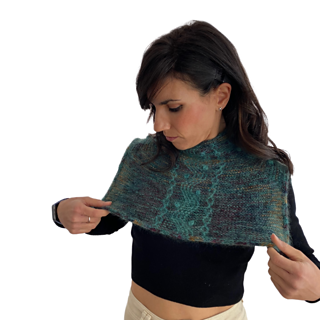patterns >  Beagleknits
Beagleknits
> Acebo Collar















Acebo Collar
ENGLISH & ITALIAN BELOW
Acebo es un cuello con canesú con hombro tipo martillo top-down que se empieza a tejer en circular desde del cuello. A continuación, se dividen los puntos entre delantero, espalda y hombros. A partir de aquí se harán aumentos en todas las vueltas a cada lado de ambos hombros hasta llegar al ancho deseado de los mismos. Seguidamente, se separarán el delantero y la espalda que se continuarán tejiendo en plano por separado. Para terminar, se recogen los puntos de todo el borde y se cierran con un I-Cord.
HILADO
Una madeja de Elisabeth de Aitana Villa Yarns (72% kid mohair, 28% seda de morera) (420 m/50 g), o cualquier otro hilado lace de características similares. Será el color A (CA).
Una madeja de Rachel de Aitana Villa Yarns (100% extrafine merino 19,5 micras) (400 m/100 g), o cualquier otro hilado fingering de características similares. Será el color B (CB).
Ambos hilados se tejen juntos.
En la muestra se han usado los colores Christmas Tree (CA) y Christmas Boubbles (CB).
TALLAS Y MEDIDAS FINALES
1 (2: 3: 4) para un ancho de hombros de 37,5 (40: 42,5: 44,5: 45,5) cm.
Las medidas (en cm) son aproximadas y corresponden a la prenda terminada.
ANCHO HOMBROS: 35,5 (38: 40,5: 42,5: 43,5)
LARGO CUELLO: 12 (12: 12: 12: 12)
LARGO TOTAL: 16 (16: 16: 16: 16)
MATERIALES
- Agujas circulares de 4 mm (o las necesarias para obtener la muestra de tensión) y cables de varias longitudes dependiendo de la parte de la prenda cm (se recomiendan cables de 35, 55 y 100 cm).
- Marcadores.
- Aguja auxiliar de trenzas (opcional).
NIVEL DE DIFICULTAD Y CONOCIMIENTOS NECESARIOS
Intermedio. Debes saber hacer (encontrarás vídeos en la sección VÍDEOS DE TÉCNICAS):
- Montaje retorcido alemán.
- Montaje de lazada retorcida.
- Cruce de puntos.
- Aumentos simples (inclinados a la derecha y a la izquierda; del derecho y del revés).
- Punto Kitchener.
This is a top-down cowl and yoke with saddle shoulders worked in the round starting at the neck. Once the neck is done, the stitches are divided between the front, back, and shoulders. From there, increases are made on every round at either side of each of the shoulders to the required shoulder width. Then, the front and back are separated and worked flat. To finish, stitches are picked up around the entire edge and bound off with an i-cord bind-off.
YARN
One skein of Elisabeth from Aitana Villa Yarns (72% kid mohair, 28% mulberry silk) (420m/50g), or any other lace weight yarn with a similar fibre content. This will be colour A (CA).
One skein of Rachel from Aitana Villa Yarns (100% extrafine merino 19.5 microns) (400m/100g), or any other fingering weight yarn with a similar fibre content. This will be colour B (CB).
Both yarns are worked together.
The sample shown used the colours Christmas Tree (CA) and Christmas Boubbles (CB).
SIZES AND FINAL MEASUREMENTS
1 (2: 3: 4) for a shoulder width of 37.5 (40: 42.5: 44.5: 45.5)cm.
These measurements (in cm) are approximate and correspond to the finished item.
SHOULDER WIDTH: 35,5 (38: 40,5: 42,5: 43,5)
COWL LENGTH: 12 (12: 12: 12: 12)
TOTAL LENGTH: 16 (16: 16: 16: 16)
MATERIALS
- 4mm circular needles (or size needed to get gauge) and cables of various lengths depending on the part of the garment (recommended lengths are 35, 55 and 100cm).
- Stitch markers.
- Cable needle (optional).
DIFFICULTY LEVEL AND REQUIRED PREVIOUS KNOWLEDGE
Intermediate. You should know how to do (you will find videos in the TECHNIQUE VIDEOS section):
- German Twisted Cast-on.
- Backwards Loop Cast-on.
- Cables.
- Simple increases (left and right-leaning; knit and purl).
- Kitchener Stitch.
Acebo è uno scaldacollo con sprone e spalle a sella lavorato top-down partendo dal collo. Una volta terminato il collo, le maglie vengono divise tra davanti, dietro e spalle. In seguito, sono eseguiti degli aumenti ad ogni giro sui due lati di entrambe le spalle fino a quando queste raggiungono la larghezza desiderata. Successivamente si separano il davanti e il dietro per lavorarli in piano. Per la finitura, si raccolgono le maglie tutto intorno al bordo e le si chiude con una chiusura i-cord.
FILATI
Una matassa di Elisabeth di Aitana Villa Yarns (72% kid mohair, 28% seta mulberry) (420m/50g), o qualunque altro filato di spessore lace con caratteristiche simili. Questo sarà il colore A (CA).
Una matassa di Rachel di Aitana Villa Yarns (100% merino extrafine 19.5 microns) (400m/100g), o qualunque altro filato di spessore fingering con caratteristiche simili. Questo sarà il colore B (CB).
I due fili sono tenuti insieme durante tutta la lavorazione.
Per l’esempio mostrato sono stati usati i colori Christmas Tree (CA) e Christmas Baubles (CB).
TAGLIE E MISURE FINALI
1 (2: 3: 4) per una larghezza sulle spalle di 37.5 (40: 42.5: 44.5: 45.5)cm.
Le misure qui indicate (in cm) sono approssimate e si riferiscono al capo finito.
LARGHEZZA SPALLE: 35,5 (38: 40,5: 42,5: 43,5)
LUNGHEZZA COLLO: 12 (12: 12: 12: 12)
LUNGHEZZA TOTALE: 16 (16: 16: 16: 16)
MATERIALI
- Ferri circolari da 4mm (o nella misura necessaria per ottenere la tensione desiderata) e cavi di diverse lunghezza a seconda della sezione del capo lavorata (consiglio cavi da 35, 55 e 100cm).
- Marcapunti.
- Ferretto da treccia (opzionale).
LIVELLO DI DIFFICOLTÀ E COMPETENZE RICHIESTE
Intermedio. Hai bisogno di sapere come fare (nella sezione delle abbreviazioni e nelle istruzioni troverai dei link a dei video):
- L’avvio ritorto alla tedesca
- L’avvio a catenella.
- Trecce.
- Aumenti semplice (inclinati a sinistra e a destra; a diritto e a rovescio).
- Cucitura a punto maglia.
46 projects
stashed
98 times
23 projects
stashed
63 times
- First published: December 2023
- Page created: December 24, 2023
- Last updated: January 15, 2026 …
- visits in the last 24 hours
- visitors right now




